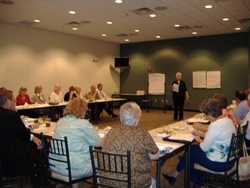Texas A&M University—Training and Education Collaborative System Preparedness & Emergency Response Learning Center (TECS-PERLC)
Building Community Capacity for Pandemic Influenza
When H1N1 flu broke in spring 2009, Texas was one of the first states with deaths from this disease. Pandemic flu caused 240 deaths in Texas between April 2009 and April 2010, and an estimated 2,316 people were hospitalized; 108 school campuses were closed to prevent further spread. The Rural Pandemic Influenza Public Engagement (R-PIPE) Project built community capacity by organizing local resources to create local solutions to improving community health.
 In rural areas, it is especially important to engage the broader community, since these communities lack resources often found in urban and suburban communities and are frequently dependent on non-traditional partners and volunteers in planning and response. The R-PIPE Project was successful in engaging a wide range of stakeholders in planning meetings, an educational conference, a series of work group meetings, town hall meetings and community education. Between the two rural counties involved in this project, 129 stakeholders representing 74 different organizations, agencies or stakeholder groups:
In rural areas, it is especially important to engage the broader community, since these communities lack resources often found in urban and suburban communities and are frequently dependent on non-traditional partners and volunteers in planning and response. The R-PIPE Project was successful in engaging a wide range of stakeholders in planning meetings, an educational conference, a series of work group meetings, town hall meetings and community education. Between the two rural counties involved in this project, 129 stakeholders representing 74 different organizations, agencies or stakeholder groups:
- identified local priority issues and concerns
- identified concrete solutions and next steps to address these issues
- identified additional stakeholders to attend work group meetings
- planned town hall meetings and community-wide education activities
 While the project goal was planning for local pandemic flu issues, one of the primary outcomes was the development of a stronger communication and resource-sharing network between stakeholders and the public. Three years after the project, this network still operates. Should any other type of local issue or concern arise in which communication and collaborative problem-solving are necessary, there is already a strong network of engaged community members in place.
While the project goal was planning for local pandemic flu issues, one of the primary outcomes was the development of a stronger communication and resource-sharing network between stakeholders and the public. Three years after the project, this network still operates. Should any other type of local issue or concern arise in which communication and collaborative problem-solving are necessary, there is already a strong network of engaged community members in place.
“The R-PIPE project really made a difference here. It put public health in the forefront and got it respect. Our community benefitted from this project and public health benefitted.”
Gwen Mills, MNSc, RN, Director, Comal County Health Department
The Training and Education Collaborative System Preparedness and Emergency Response Learning Center (TECS-PERLC) is a collaboration among the Texas A&M School of Rural Public Health, the University Of Texas School Of Public Health, and the University Of North Texas Health Science Center School Of Public Health. For more information about TECS-PERLC go to http://www.rural-preparedness.org/
- Page last reviewed: April 10, 2015
- Page last updated: April 10, 2015
- Content source:


 ShareCompartir
ShareCompartir